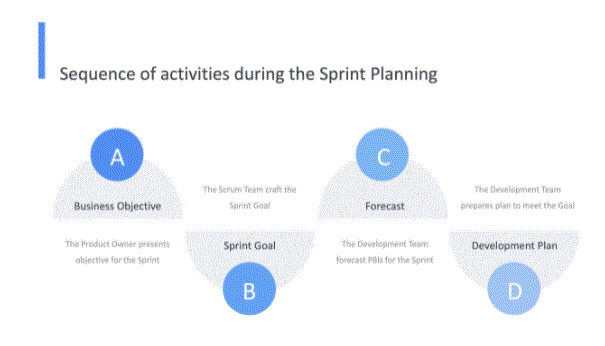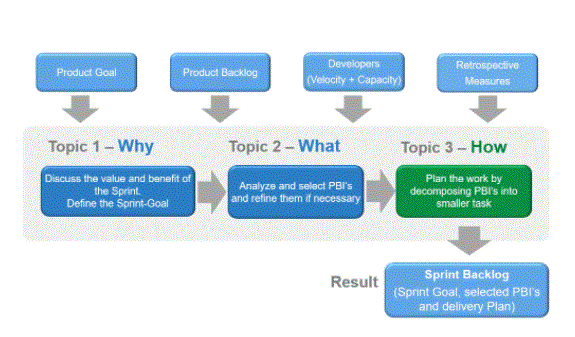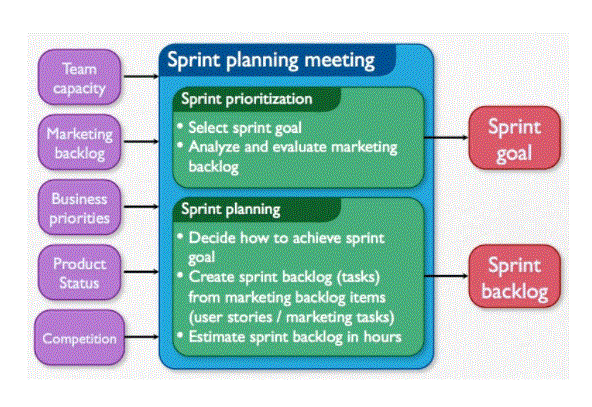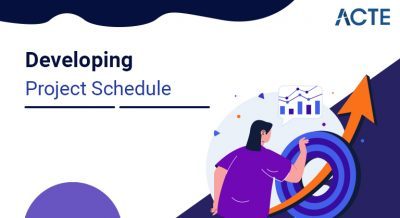
Agile Marketing Terms And Roles To Keep In Mind:
As you learn more about agile marketing and the sprint planning process, here are some terms and roles to keep in mind.
Agile Sprint Planning: A process that marketing teams can use to complete projects efficiently and effectively.
Burndown chart: A chart created during your team’s sprint that shows how much work has been done, how much is in progress, and how much still needs to be completed.
Definition of complete: Your project’s performance standards should be considered complete.
Daily Scrum Meeting: It is also called a Standup meeting. A 15-minute daily meeting between members of a scrum team that reviews the work completed the day before, the work that will be completed today, and any obstacles they are running into.
Project Backlog: A place where all upcoming projects and their tasks are stored until they are added to the Sprint by the Scrum Master.
Project Owner: This is the person who is in charge of conceptualising a project and determining what goals the project needs to accomplish. They are in charge of coming up with a clear vision of what the team has to offer.
Scrum: A framework that marketing teams can use to address large complex projects and break them down into smaller pieces to increase productivity and avoid missed deadlines.
Scrum Master: The person who oversees the entire Scrum team and makes sure everyone is working productively. They inform the project manager about the ability and velocity of the scrum team to plan an effective sprint.
Scrum Team: A group of five to nine people responsible for executing tasks in a project that have been assigned to them by the Scrum Master.
Sprint: The scrum team is committed to completing a certain amount of work within a given time frame.
Sprint Backlog: Tasks and projects transferred from the project backlog that a scrum team will commit to complete within a sprint.
Sprint Cycle: A two to four week time frame in which a full sprint is completed.
Sprint Planning Meeting: A time where the Project Manager, Scrum Master and Scrum Team come together to assign work for the upcoming Sprint.
Sprint Review/Retro: This is the time to review what went well in the sprint and what didn’t as well as find out why the work was not done or completed on time.
Velocity: How quickly a team can complete work within a sprint.

- Project owners meet with stakeholders to gather information and set goals on a project
- The first step in your sprint planning process is for your project manager to gather information about the upcoming project. This may mean that they meet with a client or stakeholders to find out what goals need to be met for the project.
- These goals should be entered in your template:
- Project Owner takes notes and moves tasks to Project Backlog
- During the project meeting, the project owner needs to focus on what the stakeholders hope to achieve.
- From there, the project owner will turn those notes and goals into tasks that can be kept in your project backlog.
- The Project Owner and Scrum Master meet to determine what tasks the team can take on
- After the tasks are added to the backlog, the Project Owner and Scrum Master will review possible tasks to see what could be done by the team.
- This will also be the time when the Scrum Master and Project Owner will determine who should be on the scrum team for this particular project.
- The Scrum Master reviews the velocity of the team.
- Your team’s velocity is the capacity your team has to complete work on a project backlog and the number of times they have completed that task.
- Your Scrum Master can estimate velocity with some basic maths. Each project your team completes in a sprint has a fixed point value.
- So if your team completes four projects that are worth 15 points per piece, your velocity will be 60.
- This is something that a scrum master would need to observe and evaluate over time.
- If we go back to our example, let’s say in a week your team delivers 4 projects worth 60 points. Next week they deliver 3 projects of 45 marks each. So the velocity of the team will now be 52.5.
- The Scrum Master determines the length of the sprint.
- After looking at the scope of the project, the Scrum Master needs to determine how much time the sprint needs to complete the project.
- To find out, your Scrum Master will need to estimate the amount of time that is attached to each task and the total time.
- Then based on the number of hours potential scrum team members can work, the scrum master can determine how much time the sprint will need to complete the work.
- For example, if a series of tasks adds up to 80 hours a week and two team members can each work forty hours a week, the length of the sprint should only be one week.
- Remember that there may need to be multiple sprints to complete a project.
How To Effectively Plan Agile Sprints:
Now that you know the language used for sprint planning, you can start planning your sprint. It traditionally includes 17 different stages to complete a sprint from start to finish.
Step One:
Step Two:
Step Three:
Step Four:
Step Five:
- After scheduling the sprint and tasks, the scrum master will convene a sprint planning meeting.
- It is standard that every hour of your sprint planning meeting coincides with a week’s worth of sprints.
- So a two week sprint would potentially require a two hour planning meeting.
- Of course, if you’re working by the book. If you don’t need to take two hours, run a shorter meeting, but don’t go over that time.
- Scrum team discusses ability to work in sprint
- At this point, your team should know that they each have the ability to get the job done.
- This means that if your content writers only have 32 hours to work in a week, you shouldn’t book them for 40 hours of work.
- At this point, the Scrum Master should pull up tasks from the project backlog and delegate them to team members. Each task should be associated with a time period that the team member has to complete.
- Once tasks are assigned to team members, they are moved to the Sprint Backlog. The Sprint Backlog is the amount of work completed by your team.
Scrum Master schedules sprint planning meeting:
Tasks assigned to the scrum team:

- Team members now need to add up the time they have for each task. Once they have the totals, they need to compare the total hours of their tasks and the time worked during the sprint.
- For example, let’s say a content writer was assigned 72 hours of work for a two-week sprint. However, they see that they have the capacity to work 80 hours in this sprint. They can either add extra work or figure out another way to allocate those eight hours.
- Scrum team brings forward issues, questions and constraints.
- During your sprint planning meeting, your team should address any problems, questions or bottlenecks that occurred in the previous sprint.
- Your scrum team should discuss and figure out how to avoid problems in the next sprint.
- Scrum master asks for agreement on selected sprint.
- If everyone on the team agrees with what the Sprint Backlog looks like, you can finalise your Sprint.
Scrum team adds up time for tasks they are assigned and confirms their work capacity:

- Your team should discuss:
- what went well.
- What didn’t go well
- what can be improved.
- What needs to be stopped to improve the next sprint.
- What needs to be started to improve the next sprint.
- Your team will also inspect your burn chart in the process. Your burnchart is a visual representation of how your team got through your sprint workload.
- Project owner sets the launch date for the project and presents it to stakeholders
- After the sprint is complete and the deliverable products have been approved, the project owner will present the completed work to the stakeholders.
Sprint finishes and sprint review/retro takes place:
After your team completes the sprint, the entire group (including the Scrum Master and Project Owner) will gather to review the sprint.
- This has allowed us to work efficiently and bring our customers the features of their choice.
- In fact, using this method allowed us to launch four major features in less than six weeks.
- CoSchedule uses agile sprint planning and has incorporated it in a way that works for us.
- For example, our demand generation team uses the Sprint Backlog to keep track of all of our projects. We also have room to introduce new ideas and plans for team members to work on.
- From that backlog, we choose ideas that are 10x or allow us to grow our company 10x faster.
- (Garrett also wrote a book on the subject if you want to learn more about that process).
- From there we use our backlog to fill our week-long sprint. These short sprints keep us working as fast and efficiently as possible.
- For CoSchedule, using an agile sprint process keeps the whole team moving faster.
- From our failures, we learn how to do better and improve. As we improve, we never make mistakes again.
- This means that you do not need to use Agile Sprint Planning in its purest form. You can adjust the process to suit your marketing team.
- Try Agile Sprint Planning With Your Marketing Team
- Now you know everything about Agile Sprint Planning. Bring this idea back to your marketing team and try it for a couple of weeks to see if it makes a difference to your team.
How CoSchedule Uses Agile Sprint Planning To Get Stuff Done:
This process sounds like a lot of work, doesn’t it? And is it all that effective? this is! CoSchedule uses and has been using the Scrum methodology since the company’s inception in 2013.

- Your first sprint will begin with a sprint planning meeting. This is when you and your team will determine what work you will be doing in your sprint. Because the process will be unfamiliar at first, give yourself plenty of time for this first meeting.
- Prior to sprint planning, your marketing leader, whether CMO, VP, director or whatever your company calls it, should prioritise your backlog. Your backlog is a list of projects, tasks and ideas that your team is responsible for completing. These should be prioritised in order of greatest importance according to business value or time-based deadlines.
- There are specific job titles and roles for the Scrum methodology, but we won’t worry about those in this post. At the end of the day, titles don’t matter, but accountability matters.
- Research Great Welcome Email Examples
- write a copy
- design email
- Apply in our email service tool
- Set up an automation workflow to send email when someone is signed up
- publish email in production
- Depending on what works for your team, you may want to break down the tasks into even more granularity. If you want to do A/B test on your welcome email, you can make two works for copy and design, but it’s up to you. There is no right or wrong way to do your projects. Experiment with different levels of granularity and decide what’s best for your team.
- Continue to do this with items in your backlog until you have more than you know you can humanly accomplish in a single sprint.
Your first marketing sprint:
Discuss priority items:
Now that you know what’s most important, start talking about what needs to happen to meet the requirements of the project or task. For example, if the project is to create a welcome email for signups on your website, you can break it down like this:
- The next step is to assign a size to each of your backlog items. This is to help you learn over time how much work your team can handle in any given sprint. Sizing is completely subjective and no two teams do it exactly the same way. My personal preference is to use a numerical value because it allows you to measure your performance over time using charts and graphs. There are a few other approaches I’ve seen:
- Again, there isn’t one “right” way to do this, but my preference is to shape the entire project after discussing individual tasks rather than sizing each specific task. Granted, when you first start out, sizing each specific task can be helpful in determining the size of the project.
- If you decide to go with a numerical approach, there are card decks available online to size up your team. These are commonly called scrum poker or agile sizing cards.
- When you first start shaping, you will find that your team will be everywhere when they are scoring an activity. I can get 3 points and another member of the team can get 13 points for the same task. When this happens, you need to discuss why each of you feel that way and work to agree on a score that both of you can live with. This is often because a designer can do much less of a copywriting job than a copywriter because they don’t understand the amount of work it takes to create a copy and vice versa. We can also talk about empathy in another post
Sizing your work:
- Prior to the sprint planning meeting, your team will need a marketing backlog of work prioritised. The highest priority items are at the top of the list and are written in a way that explains what is needed, but not how to get the job done. Ideally, work should be sized with story points to indicate whether work can be completed within the sprint time box.
- The team should have an individual role who is responsible for prioritising the marketing backlog and setting the stage for what customers and stakeholders need. This role in Scrum is called Product Owner. Even if this role is not recognized in your company, a marketing strategist, project manager or team lead should be the central person in communicating goals and priorities.
- A sprint goal is a summary of what should be the main focus of work in an upcoming sprint time box, not a regurgitated list of marketing backlog items. This is a big picture way of thinking about what will be considered a success for the team in the coming week or two, that matters to customers. While teams may work on more than one client or campaign, the less and more attention they can be on a specific thing, the more likely they are to be able to accomplish something valuable rather than just getting a whole bunch of things. Will be
- Confirm our belief that our ad campaign should feature 80s music.
- Promote our upcoming virtual event.
- Create an ad for the grand opening of our new store.
Conclusion:





